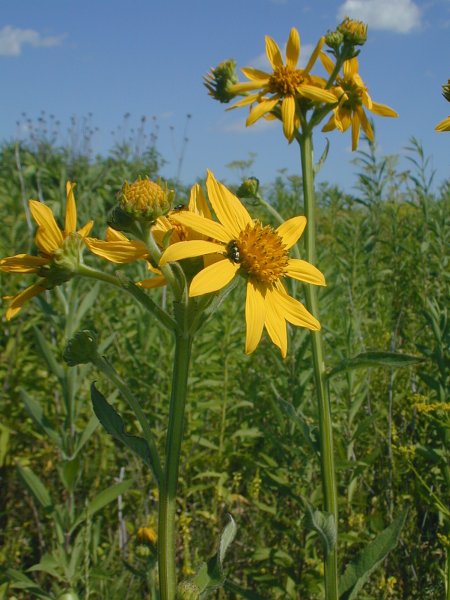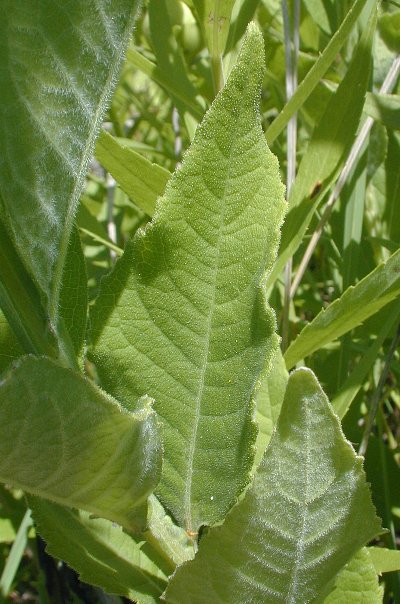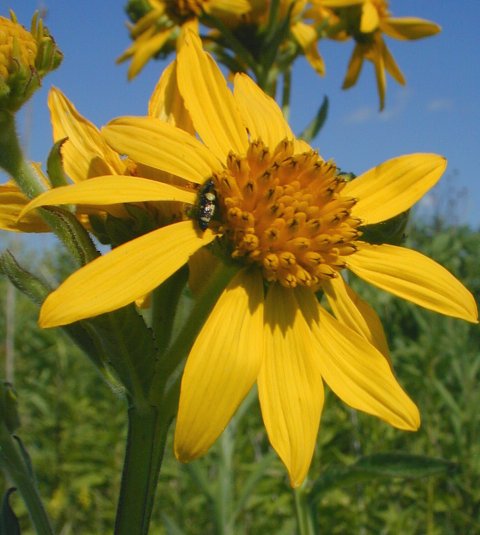Description: This perennial plant is unbranched and about 3-4' tall. The central stem is winged, with a slight scattering of small white hairs on the ridges. The alternate leaves are about 5" long and 2" wide, lanceolate to ovate in shape, rather soft in texture, and covered with small white hairs. This gives the leaves a fuzzy light green appearance, especially on their undersides. The inflorescence at the apex of the plant has several daisy-like composite flowers on rather short pedicels with abundant long white hairs.

These composite
flowers are bright yellow, about 2–2½" across, and become rather ragged
in appearance after they pass their prime. Each flower has 6-12 ray
florets, which spread outward horizontally from the central cone
(roughly), rather than drooping. The disk florets present a
pincushion-like appearance, with each disk floret projecting outward
and visibly separated from the others. The blooming period is early to
mid-summer, and lasts about a month. There is no noticeable scent to
the flowers. This plant often forms colonies from its rhizomes.
Cultivation:
The preference is full to partial sun, and mesic conditions. During a
drought this plant sometimes wilts, but recovers readily after
significant rainfall. This plant often flourishes in soil that is
loamy, and will tolerate some clay or stones. The foliage is rarely
bothered by disease.

Range &
Habitat:
The native Yellow Crownbeard occurs occasionally in the southern 3/5 of
Illinois,
from Peoria to Champaign-Urbana, and southward. It is apparently absent
elsewhere (see Distribution
Map). It occurs in mesic black soil prairies, rocky upland
forests, savannas, thickets, limestone glades, and along railroads. It
is especially likely to be observed along railroad prairies.
Faunal Associations:
Primarily long-tongued bees visit the flowers for pollen or nectar.
These include bumblebees, honeybees, large Leaf-Cutting bees, Little
Carpenter bees, and various Cuckoo bees. Other visitors include
Halictine bees, Dagger bees, and Thread-Waisted wasps. The caterpillars
of the butterfly Chlosyne nycteis (Silvery
Checkerspot) and Basilodes pepita (Gold Moth) feed
on the foliage.

Photographic
Location:
The photographs were taken at the Red Bison Railroad Prairie in Savoy,
Illinois.
Comments:
This is an attractive plant because of the fuzzy leaves; the composite
flowers are an additional bonus. Yellow Crownbeard, along with other
members of the genus, has been oddly neglected in many prairie field
guides, even though it clearly occurs in tallgrass prairies. Nor is it
easy to obtain seed or plants from nursuries that specialize in native
wildflowers, possibly because of the more southern distribution of this
species. Another member of this genus that sometimes occurs in prairies
in
Illinois, Verbesina alternifolia (Wingstem), is a
taller plant that blooms later. It has long coarse leaves that are
sandpapery, rather than soft and fuzzy, and its ray florets droop
around the central cone of each flower. A scientific synonym of Yellow
Crownbeard is Actinomeris
helianthoides.